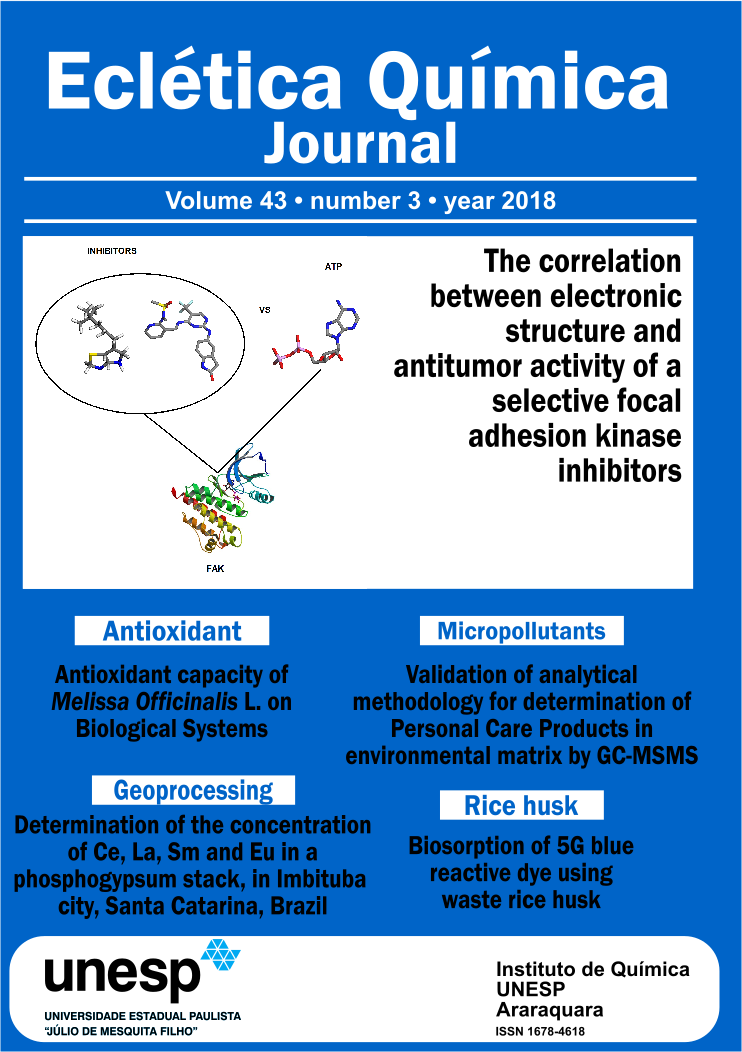Abstract
Phosphate fertilizer industry produces phosphoric acid from phosphate rocks, and as a byproduct, it produces phosphogypsum, also known as agricultural gypsum. This material was stock an open-air stacks near the producing units. In order to determine levels of rare-earth elements in phosphogypsum stacks, located in Imbituba, Brazil. Samples of 1000 grams of phosphogypsum were collected in nine different points in stack 1. The concentration of rare-earth elements was determined through neutron activation analysis and results indicate significant values of rare earth elements in the phosphogypsum from Imbituba, when compared to the values of the Earth’s crust.
References
Associação brasileira de normas técnicas. NBR 10006: Solubilização de resíduos. Rio de Janeiro, 1987.
Fernandes, H. M.; Rio, A. P. M.; Franklin, M. R. Impactos Radiológicos da Indústria do Fosfato. Série Esdutos&Documentos CETEM/MCT 56 (2004).
Koeberl, O.; Bayer, P. M. Concentrations of rare earth elements in human brain tissue and kidney stones determined by neutron activation analysis, Journal of Alloys Compounds, 180 (1998) 63 - 70. In: CHUA, H. Bioaccumulation of environmental residues of rare earth elements in aquatic flora Eichhornia crassipes (Mart.) Solms in Guangdong Province of China. The Science of Total Environment, 214 (1992) 79-85.
Gorbunov, A. V.; Frontasyeva, M. V.; Gundorina, S. F.; Onischenko, T. L.; Maksiuta, B. B.; Chen Sen Pal, Effect of agricultural use of phosphogypsum on trace elements in soils and vegetation, Science of the Total Environmental 122 (3) (1992) 337-346. https://doi.org/10.1016/0048-9697(92)90051-S
Santos, A. J. G., Mazzilli, B. P.; Fávaro, D. I. T.; Silva, P. S. C., Partitioning of radionuclides and trace elements in phosphogypsum and its source materials based on sequential extraction methods, Journal of Environmental Radioactivity 87 (2006) 52-61. http://doi:10.1016/j.jenvrad.2005.10.008
Lebourlegat, F. M. Disponibilidade de Metais em Amostras de Fosfogesso e Fertilizantes Fosfatados Utilizados na Agricultura. 2010. 88f. Dissertação (Mestrado) – Instituto de Pesquisas Energéticas e Nucleares, São Paulo, 2010.
Oliveira, K. A. P. Fator de Transferência de Elementos Terras Raras em Solos Tropicais Tratados com Fosfogesso. 2012. 133f. Tese (Doutorado) – Saneamento, Meio Ambiente e Recursos Hídricos, UFMG, Belo Horizonte, 2012.
Tyler, G, Rare earth elements in soil and plant system – A review, Plant and Soil. 267 (2004) 191- 206.
Sneller, F. E. C.; Kalf, D. F.; Weltje, L.; Wezel Van, A. P. Maximum Permissible Concentrations and Negligible Concentrations for Rare Earth Elements (REEs). IVM-National Institute for Public Health and the Environment, report 601501011: The Netherlands, 2000.
Lapido-Loureiro, F. E. Fertilizantes e sustentabilidade: o fósforo na agricultura brasileira, Série de Estudos e Documentos, CETEM, 2008.
Ihlen, P.M., Schiellerup, H, Gautneb, H, Skar, O, Characterization of apatite resources in Norway and their REE potential - A review, Ore Geology Reviews 58 (2013) 126–147. https://doi.org/10.1016/j.oregeorev.2013.11.003
Fortescue, J. A. C., Landscape geochemistry: retrospect and prospect – 1990, Applied Geochemistry, 7 (1992) 1-53.
Kabata-Pendias, A. & Pendias, H, Trace elements in soils and plants, Boca Raton, 2rd ed., 1992.
Uchida S, Tagami K, Hirai I, Soil-to-plant transfer factors of stable elements and naturally occurring radionuclides (1) Upland field crops collected in Japan, Journal of Nuclear Science and Technology 44 (4) (2007) 628-640. http://dx.doi.org/10.1080/18811248.2007.9711851

This work is licensed under a Creative Commons Attribution 4.0 International License.
Copyright (c) 2018 Eclética Química Journal




